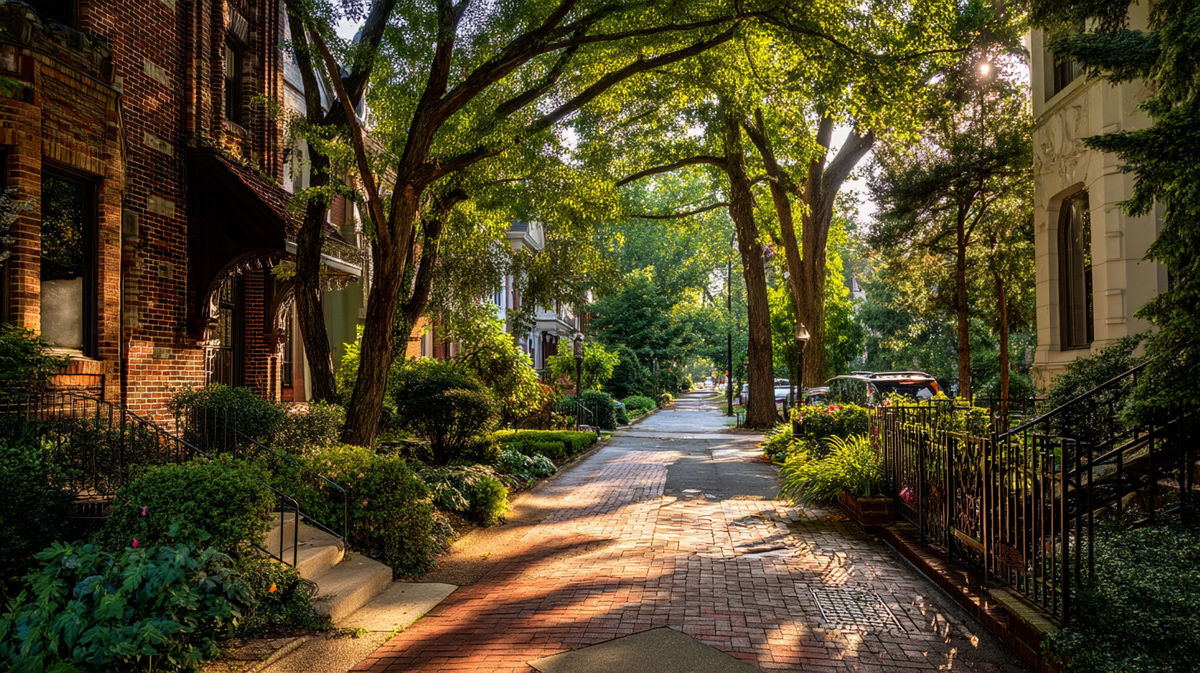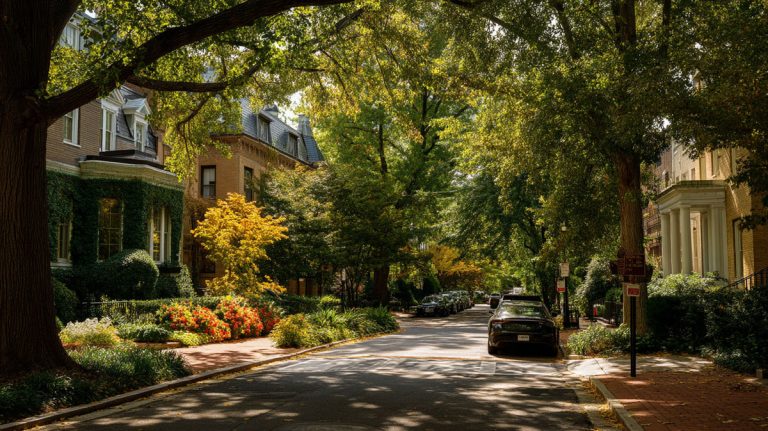Overview of Kalorama
Introduction to Living in Kalorama, DC
Kalorama feels like a tucked‑away European village folded right into the District of Columbia. Mansions brush shoulders with apartment buildings, embassies dot leafy streets, and residents swap stories over coffee at the corner café. People who used to live here swear they still walk back just to feel the calm.
Even though the neighbourhood sits a little higher in elevation, a gentle height above Rock Creek Park, the whole area is only a 15‑minute walk from Dupont Circle’s metro stop, putting the city at your doorstep. You’ll pass playgrounds, a quiet park, and enough independent restaurant patios to keep a foodie busy.
Add in steady demand for homes for sale in Kalorama, and it’s easy to see why many buyers tag it among the best places to live in Washington.
Geographical Location
Kalorama stretches west from 16th Street to Connecticut Avenue, tucked between Adams Morgan and Woodley Park, with Georgetown just down the hill.
A quick glance at any map shows how convenient the location is. Capitol Hill meetings in the morning, Smithsonian strolls by lunch, and Columbia Road nightlife after dark are all within walking distance.
Cost of Living in Kalorama
Living here isn’t cheap. Zillow’s latest report pegs the average home value at about $1.34 million in mid‑2025, with median sale prices cresting $3.3 million for larger properties.
Rents mirror that premium: studios hover near $2,000 a month while two‑bedroom flats can top $4,500.
For buyers eyeing long‑term real estate gains, or tenants splitting a spacious pre‑war flat, the neighborhood of Washington remains a coveted address.
Kalorama Crime Reports and Data
Property Crime
AreaVibes estimates roughly 4,040 property crimes per 100,000 residents, giving locals a one‑in‑25 chance of experiencing burglary, theft, or motor‑vehicle theft in a given year.
That’s higher than national averages yet below many dense sections of downtown DC.
Violent Crime
Violent incidents, including assault, robbery, and homicide, run about 501 per 100,000.
In practical terms, the odds of becoming a victim of violent crime here sit near one in 200, better than several inner‑core neighborhoods but still above suburban benchmarks.
Other Crime
Theft from autos remains the biggest nuisance. City‑wide, MPD logged 3,464 such cases in the first half of 2025, a small year‑over‑year dip that echoes Kalorama’s own decline in porch‑piracy and catalytic‑converter theft MPDC.
Trends in Kalorama Crime Rates
Big picture? The overall DC crime curve is bending downward. Violent crime across the District fell 26 percent year‑to‑date compared with 2024, hitting a thirty‑year low.
Kalorama’s numbers follow that trajectory, with property crime easing about five percent and robbery complaints falling by double digits since 2023.
Comparing Crime Rates: Kalorama vs. Nearby Cities
Comparison of Kalorama Crime Rates with Washington, DC
Kalorama records about 4,541 crimes per 100,000 residents, roughly 13 percent below the District average of 5,205. Violent crime shows the biggest gap: 501 per 100,000 here versus 1,047 citywide.
Property crime is nearly even with 4,040 locally against 4,158 across DC, so the odds of a theft sit near one in 25 either way.
Embassy security details and a high share of owner‑occupied homes help keep those violent‑crime numbers low, giving the neighborhood a calmer feel than many downtown blocks.
Crime Rate Comparison with Nearby Neighborhoods
Woodley Park posts roughly 2,497 crimes per 100,000, making it noticeably quieter.
Dupont Circle, by contrast, sees around 7,350 crimes per 100,000, while Adams Morgan lands in the middle with rates 54 percent above the national norm.
In short, Kalorama sits in a “middle‑low” tier—safer than the nightlife hubs but not as tranquil as its Rock Creek‑hugging neighbor.
Safety Measures and Resources
Chance of Being a Victim of Crime in Kalorama
Crunching those statistics means an overall one‑in‑23 likelihood of any crime in a year, yet many locals still describe the streets as “low crime” after dark thanks to embassies’ private security patrols.
Role of the Kalorama Police Department
Kalorama falls under the Third District of the Metropolitan Police Department, which also covers Dupont Circle, Columbia Heights, and Adams Morgan.
Officers liaise with local PSAs, share monthly safety updates on the MPD website, and rely on CCTV nodes installed along Columbia Road to deter burglary hotspots.
Community Safety Initiatives
Block captains organize a WhatsApp tree, embassy guards report suspicious traffic to MPD, and neighborhood associations push “Walkable Kalorama” campaigns that lobby DOT for better lighting, one factor behind falling break‑in numbers.
Living in Kalorama: Is it a Safe Place to Live?
Ask ten residents and you’ll hear nine say they feel safe walking home from dinner. They’ll point out that the wide sidewalks let strollers pass joggers with ease, that Georgetown is a brisk walk along Q Street, and that late‑night coffee spots keep eyes on the street.
Parents note that Kalorama Park sits steps from acclaimed schools, and commuters praise quick Red Line access that keeps traffic headaches low compared with outer‑belt suburbs.
As one long‑time owner put it, “I’d happily live in Kalorama Heights again, so would my dog.”
Conclusion and Recommendations
Summary of Crime Statistics
Kalorama’s crime rates sit roughly 99 percent above national levels but trend below DC’s average. Violent crime is lower than you might expect in a dense international quarter, and property crime, while elevated, shows gradual improvement.
Future Outlook for Crime in Kalorama
MPD staffing boosts, neighborhood CCTV expansion, and steady homeowner investment signal a continued slide in incident counts.
Buyers who prioritize walkable, embassy‑anchored streets and can handle premium prices will likely see their home values hold strong as the district pushes for the safest streets in Northwest.
Kalorama Safety FAQs
How does Kalorama compare to Woodley Park and Adams Morgan for safety?
Woodley Park’s total‑crime rate is roughly half of Kalorama’s, while Adams Morgan’s sits higher. Kalorama offers a balance between nightlife energy and quieter residential feel, so your comfort level may hinge on proximity to bar corridors.
Is Kalorama within walking distance of a Metro station?
Yes. Dupont Circle’s Red Line entrance is about a 15‑minute stroll, and Columbia Heights’ Green/Yellow Line stop is an extra few blocks if you like to walk.
Does the presence of embassies make the neighborhood safer?
Embassy security staff supplement MPD patrols and often deter opportunistic crime, especially near Massachusetts Avenue. That additional watchfulness is one reason some buyers call Kalorama “quiet but convenient.”
Are there parts of Kalorama Heights I should avoid after dark?
Most streets feel comfortable, yet the alleyways behind Connecticut Avenue shops can see late‑night theft‑from‑auto spikes. Stick to well‑lit routes—another factor behind Kalorama’s walkability improvements.
Where can I find official crime data for Kalorama?
MPD’s Crime Cards dashboard offers an interactive map and downloadable report, while third‑party sources like Niche and AreaVibes publish yearly ranking snapshots that compare neighborhoods across the District of Columbia.


